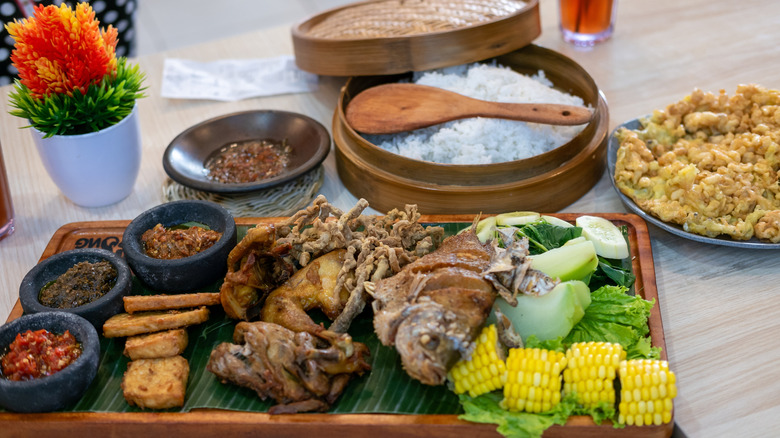Rick Steves Recommends Trying This Unique Hybrid Dish When Visiting Amsterdam
Traveling is all about opening yourself up to new adventures, and that includes food! While some of us are definitely more adventurous than others when it comes to trying new foods, the best way to learn about a culture can be through trying and learning about its delicious cuisine. Travel expert Rick Steves has been taking curious adventurers along with him on his European travels since the early 1970s, and along the way, he's tried his fair share of unique foods. While his adventures have taken his taste buds global, one Dutch dish in particular stood out.
On a trip to Amsterdam, in his blog piece titled "Sensory Amsterdam," Steves discusses his experience with rijsttafel (pronounced RYE-stah-ful), an Indonesian-Dutch hybrid dish that literally translates to "rice table." Steves wrote, "Though not a true Indonesian meal, it's a Dutch innovation designed to highlight the best food of its former colony, especially all the great spices that funded the city's Golden Age. For around $40 you get about 20 dishes and a rainbow of spices with white rice to mix and mingle on your palate." While the Dutch and Indonesian peoples share a long, sordid colonial history, and the dish is technically not a product of Indonesia at all. Indonesia's spices and a certain way of serving multiple small dishes at once inspired the Dutch to bring the idea back with them to the Netherlands after their colonization of the archipelago. So what is rijsttafel anyway?
What is rijsttafel?
Rijsttafel isn't simply a meal; it's a full-blown food-tourism experience — one that represents both Dutch and Indonesian culinary history. Picture a long table filled to the brim with small plates: crispy vegetables, tender meat dishes like sate, fish, spiced curry, a vegetable salad with peanut sauce, and a steaming portion of white rice in the center of it all. Like chicken tikka masala, which was invented in the U.K. by South Asian immigrants, the dish might not be from Indonesia, but it uses ingredients, spices, meats, and practices inspired by Indonesian cuisine.
Some say this communal style of eating was adapted from a Sumatran style of eating called nasi padang. In an interview with Folklife Magazine, California-based Indo chef and author Jeff Keasberry said of the dish, "It was inspired by Java, on the slametans [communal feasts]. Feasting, celebrating, and ceremonial meals were a way of showing thanks and involving people." While you'd be hard-pressed to find rijsttafel at a restaurant in Indonesia, the Dutch have been creating the dish for decades. According to Folklife Magazine, in November 2022, rijsttafel was even added to the Netherlands' Intangible Heritage Inventory, showing its prominence among Dutch culture.
The culinary experience that is rijsttafel
Today, rijsttafel stands as one of the most distinctive and celebrated dining experiences in the Netherlands, a feast that bridges two very different cultures through the universal language of food. Each plate, no matter how small, tells a story: of spice routes that connected continents, of colonial exchange and adaptation, and of how traditions evolve to create something entirely new. It's a meal that encourages conversation and education, not only between friends but also within communities, learning about and understanding the dishes and where they came from. In Amsterdam, rijsttafel has become something of a rite of passage for visitors looking to experience the city beyond its canals and museums (as well as experience Indonesian food for the first time). In 2023, even the Netherlands' prime minister decided to take the French president out to a rijstaffel dinner during an official visit.
Restaurants across the city offer diners their own interpretations of the dish, some hewing closely to tradition while others have reimagined rijsttafel for a more modern palate. Tujuh Maret is a family-run restaurant serving up delicious, classic (and spicy) rijsttafel dishes, and Eater even named it as one of the top 23 restaurants in Amsterdam. Restaurant Blauw, on the other hand, offers a more contemporary take, presenting beautifully plated dishes with a unique twist. For something a bit more refined (and expensive), try Blue Pepper, which serves its rijsttafel over five courses versus all at once. Despite the complicated history of Dutch colonization in Indonesia, one thing about this comfort food is certain: It brings about a sense of community, memories, and cultural education that continues to resonate today. Each bite is a reminder of the shared history that shaped the Netherlands' culinary identity, transforming a colonial legacy into a celebration of flavor and connection.


